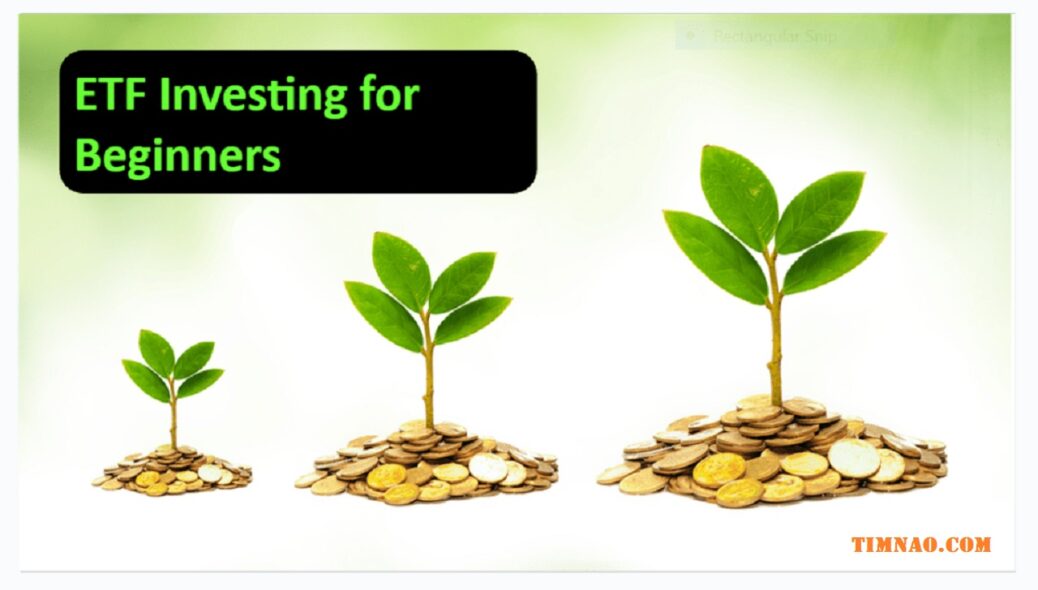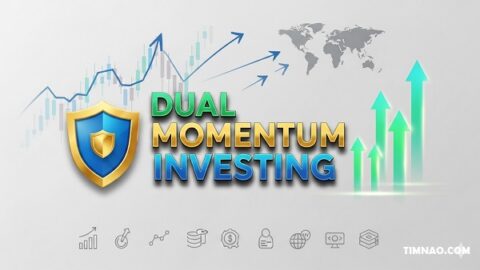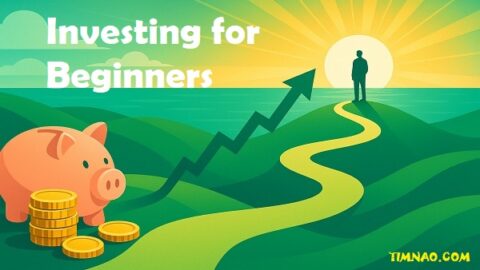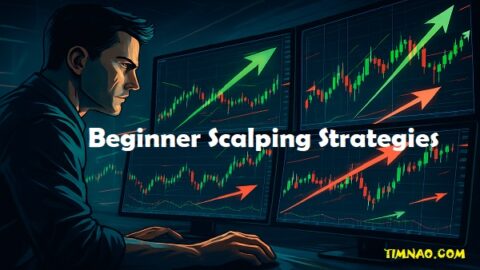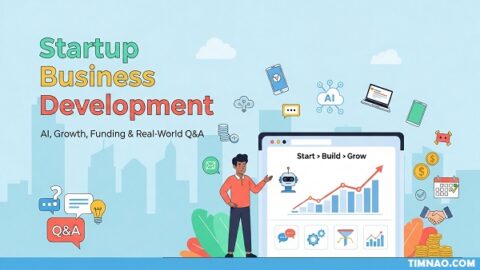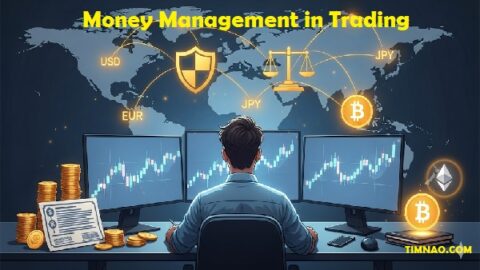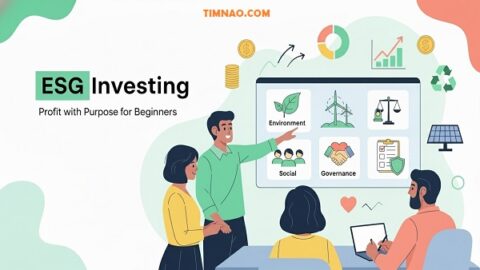Unlock Wealth in 2025: Your Ultimate Guide to Succeed in ETF Investing for Beginners
Your Journey to ETF Investing Begins Now! 🚀
Successfully investing with ETFs might sound complex, but it’s become one of the most accessible and effective ways for beginners to build long-term wealth. If you’re looking for a cost-effective, transparent, and flexible way to enter the investment world in 2025, Exchange-Traded Funds (ETFs) could be your perfect starting point. Forget the days when investing felt reserved for the Wall Street elite; ETFs have democratized investing, allowing anyone to participate in the potential growth of diverse markets without needing a finance degree.
This guide is designed specifically for ETF investing for beginners. We’ll break down everything you need to know, from the absolute basics to crafting your own ETF strategies for 2025 and beyond. Think of this not as a dense textbook, but as a friendly conversation guiding you step-by-step towards successfully investing with ETFs. We’ll explore why low-cost ETFs are a game-changer, how to choose the right ones, build a diversified portfolio, navigate potential risks, and even peek into the exciting future of this investment vehicle. Let’s unlock your investment potential together!
🤔 What Exactly Are ETFs? Demystifying the Basics
Let’s start at the beginning. Successfully investing with ETFs requires understanding what they are. An ETF, or Exchange-Traded Fund, is a type of investment fund that holds a collection of assets – like stocks, bonds, or commodities1 – but trades on major stock exchanges just like an individual stock. Think of it as a basket holding many different investments. When you buy a share of an ETF, you’re essentially buying a small piece of every investment inside that basket.
How Do ETFs Work?
ETFs typically aim to track the performance of a specific index. For example, an S&P 500 ETF holds stocks of the 500 largest U.S. companies included in the S&P 500 index. If the index goes up, the ETF’s value generally goes up too (and vice versa). This is often called “passive investing” because the fund manager isn’t actively trying to pick winning stocks but simply mirrors the index. This passive approach is a key reason why ETFs often have lower fees than traditional actively managed mutual funds.
You can buy and sell ETFs throughout the trading day at fluctuating market prices, just like stocks. This offers flexibility that traditional mutual funds (which are typically priced only once per day) don’t provide.
A Brief History: From Niche to Mainstream
The ETF journey began in 1993 with the launch of the SPDR S&P 500 ETF (ticker: SPY) in the US, designed to track the S&P 500 index. This innovation combined the diversification benefits of index mutual funds (pioneered by John Bogle of Vanguard) with the trading ease of stocks. Since then, the ETF market has exploded! Today, thousands of ETFs exist globally, covering nearly every imaginable market, sector, commodity, and investment strategy.
Different Flavors of ETFs 🍦: Types You Should Know
ETF investing for beginners involves understanding the main categories:
- Stock ETFs (Equity ETFs): The most common type. These track stock market indexes, like the S&P 500 (US large companies), MSCI World (global developed markets), or FTSE All-World (global developed and emerging markets). They offer broad exposure to the stock market.
- Examples: Vanguard S&P 500 ETF (VOO), iShares Core S&P 500 ETF (IVV), Vanguard Total World Stock ETF (VT), iShares MSCI World ETF (URTH).
- Bond ETFs (Fixed Income ETFs): Invest in various types of bonds (government, corporate, etc.). They are generally considered lower risk than stocks and can provide regular income.
- Examples: iShares Core U.S. Aggregate Bond ETF (AGG), Vanguard Total International Bond ETF (BNDX).
- Commodity ETFs: Track the price of physical commodities like gold, silver, or oil. Often used for diversification or as a hedge against inflation.
- Examples: SPDR Gold Shares (GLD), iShares Silver Trust (SLV), United States Oil Fund (USO).
- Sector and Thematic ETFs: Focus on specific industries (e.g., technology, healthcare, energy) or investment themes (e.g., clean energy, artificial intelligence, robotics, cybersecurity). These allow you to target areas you believe have high growth potential but can be riskier.
- Examples: Technology Select Sector SPDR Fund (XLK), iShares Global Clean Energy ETF (ICLN), Global X Robotics & AI ETF (BOTZ), ARK Innovation ETF (ARKK).
- Factor (Smart Beta) ETFs: Track indexes but use alternative weighting methods based on “factors” like value, growth, momentum, low volatility, or dividend yield, aiming to enhance returns or reduce risk compared to traditional market-cap weighting.
- Examples: iShares MSCI USA Value Factor ETF (VLUE), Invesco S&P 500 High Dividend Low Volatility ETF (SPHD).
- Active ETFs: Unlike most ETFs, these are actively managed by a fund manager trying to outperform a benchmark index, rather than just track it. They offer potential for higher returns but usually come with higher fees and their success depends heavily on the manager’s skill. The number of active ETFs has been growing rapidly.
- Examples: ARK Innovation ETF (ARKK), JP Morgan Equity Premium Income ETF (JEPI).
Understanding these basic types is the first step towards successfully investing with ETFs.
🌟 Why Choose ETFs? The Awesome Advantages
Okay, so you know what ETFs are. But why have they become so popular, especially for ETF investing for beginners? The advantages are compelling:
1. Diversification Made Easy 🧺
This is a big one. Diversification means spreading your money across many different investments to reduce risk. If one investment performs poorly, others might do well, cushioning the blow. ETFs are inherently diversified because they hold numerous underlying securities. Buying one share of a broad market ETF, like a FTSE All-World ETF, gives you instant exposure to thousands of companies across dozens of countries. Achieving this level of diversification by buying individual stocks would be time-consuming and expensive.
2. Cost Efficiency = More Money in Your Pocket 💰
ETFs are famous for being low-cost ETFs. Because most are passively managed (just tracking an index), their operating costs are minimal. These savings are passed on to you through a low “expense ratio” (also called Total Expense Ratio or TER). The TER is the annual fee charged by the fund, expressed as a percentage of your investment.
Compare typical ETF TERs (often below 0.20%, some even below 0.05%!) to actively managed mutual funds, which can easily charge 1% or more. This difference might seem small, but over decades of investing, high fees can drastically eat into your returns due to the power of compounding. Lower fees mean more of your money stays invested and working for you. Popular ETFs like Vanguard’s VOO and iShares’ IVV boast TERs as low as 0.03%. Also, unlike some mutual funds, ETFs typically don’t have “sales loads” or commissions charged just for buying them (though standard brokerage commissions may apply).
3. Transparency: Know What You Own 🔍
ETFs generally disclose their full holdings daily. This means you can easily see exactly which stocks, bonds, or other assets your ETF holds at any given time. This transparency builds trust and helps you understand exactly what you’re investing in, unlike some traditional funds where holdings might only be disclosed quarterly.
4. Liquidity: Buy and Sell with Ease 💧
As mentioned, ETFs trade on stock exchanges like individual stocks. This means you can buy or sell them anytime during market trading hours at the current market price. This high liquidity is especially beneficial if you need to access your money quickly or want to react to market changes (though frequent trading isn’t usually recommended for beginners). Highly traded ETFs like SPY have enormous trading volume, meaning it’s very easy to buy or sell shares without significantly impacting the price.
5. Flexibility: A World of Choice 🌍
The sheer variety of ETFs available offers incredible flexibility. Whether you want broad exposure to the entire global market, want to target specific countries or regions, focus on certain sectors like tech or healthcare, invest according to ESG (Environmental, Social, Governance) principles, or implement sophisticated factor strategies, there’s likely an ETF for that. This allows you to tailor your portfolio precisely to your investment goals, risk tolerance, and even personal values.
6. Tax Efficiency (Often!) 🧾
In many jurisdictions (like the US), ETFs can be more tax-efficient than traditional mutual funds. Due to their structure and generally lower turnover (less frequent buying and selling of underlying assets in passive funds), they tend to generate fewer taxable capital gains distributions for investors to pay taxes on each year. Choosing accumulating ETFs (which reinvest dividends internally) over distributing ETFs (which pay dividends out) can also impact your tax situation depending on your local tax laws. Note: Tax laws vary significantly by country; always consult a local tax professional.
These advantages make ETFs a powerful tool for successfully investing with ETFs, especially for those just starting their 2025 ETF guide journey.
🎯 Choosing the Right ETFs for You, Finding Your Match
With thousands of ETFs available, how do you pick the right ones for your ETF investing for beginners portfolio? It’s less daunting than it seems if you focus on key criteria:
1. Define Your Goals & Strategy First
Before looking at specific ETFs, what are you trying to achieve? Retirement? A house down payment? What’s your timeline? How comfortable are you with risk? Your answers will guide your ETF selection. Are you building a core portfolio for long-term growth, or adding specific satellite positions for tactical reasons?
2. Understand the Index or Strategy
What market or strategy does the ETF track?
- Broad Market: ETFs tracking indexes like the S&P 500, MSCI World, or FTSE Global All Cap offer wide diversification. Great for core holdings.
- Specific Regions/Countries: Want to invest specifically in Europe, Emerging Markets, or Japan? There are ETFs for that.
- Sectors/Themes: Investing in tech (XLK), clean energy (ICLN), or AI (BOTZ)? Understand the concentration risk.
- Factors/Smart Beta: If considering a value (VLUE) or low volatility (SPLV) ETF, understand the factor methodology.
- Active ETFs: For actively managed ETFs like ARKK, research the manager’s philosophy and track record.
Know what’s “under the hood” before you buy.
3. Focus on Low Costs (Expense Ratio/TER) 📉
We hammered this in the advantages, but it bears repeating: Low-cost ETFs are crucial for long-term success. The TER directly reduces your return. For core holdings tracking major indexes, aim for the lowest TER possible. ETFs from providers like Vanguard (VOO, VTI), BlackRock’s iShares (IVV, ITOT), and Schwab (SCHB) often have rock-bottom fees (e.g., 0.03%). Compare TERs carefully when choosing between similar ETFs.
4. Check Trading Volume and Liquidity 📊
Liquidity refers to how easily you can buy or sell an ETF without significantly affecting its price. Higher trading volume generally means better liquidity. This translates to a tighter “bid-ask spread” (the difference between the highest price a buyer will pay and the lowest price a seller will accept). A tighter spread means lower transaction costs for you. For major index ETFs (like SPY, IVV, VOO, QQQ), liquidity is usually excellent. For more niche or newer ETFs, check the average daily trading volume to ensure you can trade efficiently.
5. Examine the Tracking Error 🧐
How well does the ETF actually replicate its target index? The difference between the ETF’s return and the index’s return is the tracking error. Ideally, you want this to be as low as possible. Factors like fees, transaction costs within the fund, and the manager’s efficiency can affect tracking error. Reputable providers tracking major indexes usually have very low tracking errors. You can often find this information on the ETF provider’s website.
6. Consider the ETF Provider 🏢
Major ETF providers invest heavily in technology, research, and infrastructure to offer reliable and efficient funds. While not the only factor, sticking with well-established providers can offer peace of mind. Key global players include:
- BlackRock (iShares): The world’s largest ETF provider, known for a vast range of ETFs (like IVV, EEM, ICLN) and high liquidity.
- Vanguard: Pioneer of low-cost index investing, renowned for extremely low TERs on core ETFs (like VOO, VTI, VT, VWO).
- State Street Global Advisors (SPDR): Launched the very first ETF (SPY) and offers a wide range, including popular sector ETFs (like XLK, XLE) and gold (GLD).
- Invesco: Known for the popular Nasdaq-100 tracking ETF (QQQ) and a range of innovative, factor-based (Smart Beta), and thematic ETFs (like RSP, TAN).
Others like Charles Schwab, WisdomTree, and First Trust also offer competitive products. Researching the provider can be part of your due diligence.
7. Accumulating vs. Distributing? 📈 vs. 💸
- Accumulating (Acc): Reinvests dividends automatically within the fund, increasing the ETF’s share price. Good for long-term growth and compounding, potentially simpler for taxes in some regions (like avoiding US estate tax for non-US investors with certain Ireland-domiciled ETFs). Examples: VWRA, CSPX.
- Distributing (Dist): Pays out dividends to shareholders, usually quarterly or annually. Good if you need regular income. Examples: VOO, SPY, IVV.
The choice depends on your income needs and tax situation.
By carefully considering these factors, you can navigate the vast ETF universe and select the funds that best align with your 2025 ETF guide for beginners.
🧭 Smart ETF Strategies for Beginners Charting Your Course
Okay, you’ve picked some ETFs. Now, how do you actually invest using them? Successfully investing with ETFs isn’t just about what you buy, but how you approach it. Here are some popular ETF strategies suitable for beginners in 2025:
1. Buy and Hold: The Power of Patience 💪
This is a classic, simple, and often highly effective long-term strategy. You buy your chosen ETFs and hold onto them for years, potentially decades, riding out the market’s inevitable ups and downs. The core belief is that markets tend to rise over the long haul, and trying to time short-term movements is difficult and often counterproductive.
- Key Element – Rebalancing: Periodically (e.g., annually), check if your portfolio’s mix (e.g., 60% stocks, 40% bonds) has drifted due to market movements. If stocks soared and now make up 70%, you’d sell some stock ETFs and buy bond ETFs to get back to your target 60/40 split. Rebalancing helps control risk and enforces discipline.
- Pros: Low trading costs, potential tax advantages (lower rates for long-term gains in many places), less stress.
- Cons: Requires patience during downturns, might miss short-term trading opportunities (which beginners should probably avoid anyway).
2. Dollar-Cost Averaging (DCA): Smooth Out the Bumps 🛣️
Timing the market (buying low, selling high) is notoriously difficult. DCA takes the guesswork out. You invest a fixed amount of money into your chosen ETF(s) at regular intervals (e.g., $200 every month), regardless of the price.
- How it Works: When prices are high, your fixed amount buys fewer shares. When prices are low, it buys more shares. Over time, this can lead to a lower average cost per share compared to investing a lump sum at potentially the wrong time. It reduces “timing risk”.
- Pros: Reduces emotional decision-making, enforces disciplined saving/investing, great for beginners investing small amounts regularly.
- Cons: In a consistently rising market, a lump-sum investment made earlier might perform better; it takes time to deploy your capital.
DCA is often considered one of the best ETF strategies for beginners, especially for long-term goals.
3. Core-Satellite Strategy: The Best of Both Worlds? ⚖️
This strategy blends passive and potentially more active approaches.
- Core: The largest part of your portfolio (e.g., 70-80%) is invested in low-cost, broadly diversified ETFs (like a global stock ETF and a broad bond ETF). This provides stability and tracks overall market returns.
- Satellites: Smaller portions (e.g., 20-30%) are allocated to more targeted investments – perhaps specific sector ETFs (tech, healthcare), thematic ETFs (clean energy, AI), regional ETFs (emerging markets), or even factor/active ETFs. These aim to potentially boost returns or add diversification, but carry more specific risks.
- Pros: Balances broad diversification with targeted opportunities, offers flexibility to adjust satellite positions.
- Cons: More complex to manage than buy-and-hold, satellite positions might have higher fees or volatility.
4. Thematic Investing: Betting on the Future 💡
Focus on specific long-term trends you believe will shape the future, like renewable energy, artificial intelligence, robotics, cybersecurity, genomics, or electric vehicles. Thematic ETFs allow you to invest in companies poised to benefit from these trends.
- Examples: iShares Global Clean Energy ETF (ICLN), Global X Robotics & AI ETF (BOTZ), ARK Genomic Revolution ETF (ARKG).
- Pros: High growth potential if the theme plays out, allows investing aligned with your interests/beliefs.
- Cons: Can be highly volatile and risky, success depends heavily on the chosen theme’s success, often higher fees than broad market ETFs. Often best used as a smaller ‘satellite’ portion of a portfolio.
5. ESG Investing: Aligning Values with Investments 🌱
Environmental, Social, and Governance (ESG) investing focuses on companies demonstrating strong practices in these areas. Demand for ESG ETFs is booming as investors seek to generate returns while promoting positive change.
- Examples: iShares MSCI USA ESG Select ETF (SUSA), Vanguard ESG International Stock ETF (VSGX).
- Pros: Allows investing according to your values, companies with strong ESG practices may be more resilient.
- Cons: Definitions of ESG can vary, performance may sometimes differ from non-ESG benchmarks (positively or negatively).
Choosing the right ETF strategy depends on your goals, risk tolerance, and time horizon. Many investors, especially beginners, find a combination of Buy-and-Hold with Dollar-Cost Averaging using low-cost, diversified core ETFs to be a great starting point for successfully investing with ETFs.
🧱 Building Your ETF Portfolio, Laying the Foundation
Portfolio construction sounds fancy, but it’s simply about putting together your chosen ETFs in a way that aligns with your goals and risk tolerance. Here’s how beginners can approach it for their 2025 ETF guide:
1. Know Thyself: Goals and Risk Profile 🧘♀️
This is step one, always.
- Goals: What are you saving for? Retirement (long-term)? Buying a house in 5 years (medium-term)? Emergency fund (short-term – Note: ETFs might not be ideal for very short-term needs due to market fluctuations)?
- Time Horizon: How long until you need the money? Longer horizons (10+ years) generally allow for taking more risk (higher stock allocation). Shorter horizons suggest less risk (higher bond allocation).
- Risk Tolerance: How comfortable are you with seeing your investments potentially lose value in the short term? Be honest! This determines your asset allocation.
2. Asset Allocation: The Big Picture Mix 📊
This is the most critical decision. It refers to how you divide your money between different asset classes, primarily stocks (equities) and bonds (fixed income). Stocks offer higher growth potential but more volatility; bonds offer lower returns but more stability and income. Other asset classes like real estate (via REIT ETFs) or commodities (like gold ETFs) can add further diversification.
Your risk profile dictates your allocation:
- Conservative: Mostly bonds (e.g., 60-70% bonds, 30-40% stocks). Prioritizes capital preservation. Suitable for low risk tolerance or short time horizons. Example Mix: 60% Bond ETF (AGG), 30% Global Stock ETF (VT), 10% Gold ETF (GLD).
- Balanced/Moderate: A mix, often around 50/50 or 60/40 stocks/bonds. Aims for a balance of growth and stability. Suitable for medium risk tolerance and medium-to-long horizons. Example Mix: 60% Global Stock ETF (VT), 40% Bond ETF (AGG).
- Aggressive: Mostly stocks (e.g., 80-90% stocks, 10-20% bonds). Aims for maximum long-term growth, accepting higher volatility. Suitable for high risk tolerance and long time horizons (e.g., young investors saving for retirement). Example Mix: 70% Global Stock ETF (VT), 15% Emerging Markets Stock ETF (VWO), 15% Thematic/Sector ETF (e.g., QQQ or ICLN).
These are just examples; your ideal mix depends on your unique situation.
3. Selecting Your ETFs (Recap) 🛒
Once you have your target asset allocation, select specific low-cost ETFs within each category, considering the factors from this part “Choosing the Right ETFs for You, Finding Your Match” (index, TER, liquidity, provider). For beginners, starting with just 1-3 broadly diversified, low-cost core ETFs (like a global stock ETF and a broad bond ETF) is often sufficient.
4. Rebalancing: Staying on Track ⚖️
Markets move, and your initial asset allocation will drift over time. If stocks outperform bonds, your stock percentage will increase, making your portfolio riskier than intended. Rebalancing involves periodically (e.g., once a year, or when allocations drift by a set percentage like 5%) selling some of the overweight asset class and buying the underweight one to return to your target mix.
- Why Rebalance? Controls risk, enforces discipline (buy low, sell high automatically), keeps your portfolio aligned with your plan.
- How Often? Annually is common. Avoid doing it too often, as it can incur transaction costs and potentially taxes. Using dividends to rebalance can sometimes be tax-efficient.
5. Keep it Simple! ✨
Especially when starting, resist the urge to overcomplicate things. You don’t need dozens of ETFs. A simple portfolio of a few broad, low-cost ETFs that aligns with your goals and risk tolerance, combined with regular contributions (DCA) and periodic rebalancing, is a powerful strategy for successfully investing with ETFs.
💸 ETFs and Taxes Understanding the Essentials
Taxes are an unavoidable part of investing, but understanding how they apply to ETFs can help you optimize your returns. Disclaimer: Tax laws are complex and vary significantly by country and individual circumstances. This is general information, not tax advice. Always consult a qualified local tax professional.
How Are ETFs Typically Taxed?
In many places (like the US), two main events trigger taxes:
- Capital Gains When Selling: If you sell ETF shares for more than you paid, the profit (capital gain) is usually taxable. The tax rate often depends on how long you held the shares. Holding for over a year typically qualifies for lower long-term capital gains tax rates, while holding for less than a year incurs higher short-term rates (often taxed like regular income). Managing holding periods can be a tax optimization strategy.
- Distributions (Dividends/Interest): If you own distributing ETFs, the dividends or interest they pay out are generally taxable income in the year you receive them, even if you reinvest them. Accumulating ETFs reinvest internally, but depending on local laws, you might still owe tax annually on the “phantom” income (e.g., via a “pre-distribution amount” calculation in some regions).
Tax Optimization Tips for ETF Investors
While specifics depend on your location, here are common strategies:
- Use Tax-Advantaged Accounts: If available in your country (like IRAs/Roth IRAs, 401(k)s in the US; ISAs in the UK; RRSPs/TFSAs in Canada), maximize contributions to these accounts. Growth and/or withdrawals can be tax-deferred or tax-free, significantly boosting long-term returns.
- Tax-Loss Harvesting: If you have investments that have lost value (outside tax-advantaged accounts), you can potentially sell them to realize a capital loss. This loss can offset capital gains from selling profitable investments, reducing your overall tax bill. Be aware of “wash sale” rules that prevent you from immediately buying back the same or a very similar investment.
- Be Mindful of Holding Periods: As mentioned, holding investments for the long term (typically over a year) often results in lower capital gains tax rates.
- Choose Tax-Efficient ETFs: Broad-based, low-turnover index ETFs are generally more tax-efficient than actively managed funds or high-turnover strategies.
- Asset Location: Consider holding less tax-efficient investments (like high-dividend stocks or actively traded funds) inside tax-advantaged accounts, while holding more tax-efficient investments (like broad index ETFs held long-term) in taxable accounts.
Understanding the tax implications is a key part of successfully investing with ETFs and maximizing your after-tax returns.
⚠️ Navigating the Risks, Potential Pitfalls in ETF Investing
While ETFs offer many benefits, ETF investing for beginners also involves understanding the potential risks and pitfalls. Being aware helps you make informed decisions and avoid common mistakes.
1. Market Risk (Systematic Risk) 📉
This is the risk inherent in the overall market. Economic downturns, recessions, geopolitical events, or unforeseen crises (like the 2008 financial crisis or the 2020 pandemic crash) can cause broad market declines, impacting almost all ETFs, especially stock ETFs. You can’t eliminate market risk, but you can manage it through:
- Diversification: Spreading investments across asset classes (stocks, bonds), regions, and sectors helps cushion blows.
- Long-Term Perspective: Riding out downturns is often better than selling in a panic. Markets historically recover.
- Asset Allocation: Holding an appropriate amount of lower-risk assets (like bonds) according to your risk tolerance helps stabilize your portfolio.
2. Specific ETF Risks 🔬
Beyond overall market movements, some risks are more specific to ETFs:
- Tracking Error: As discussed, the risk that the ETF doesn’t perfectly track its underlying index. Minimized by choosing reputable ETFs with low fees tracking liquid indexes.
- Liquidity Risk: The risk that you can’t easily sell your ETF shares at a fair price, especially during market stress. More relevant for niche, complex, or very low-volume ETFs. Highly liquid ETFs tracking major indexes generally don’t have significant liquidity issues for retail investors.
- Counterparty Risk (Synthetic ETFs): Some ETFs (less common now, especially for beginners) use derivatives (swaps) to replicate index performance instead of holding the actual assets (“synthetic replication”). This introduces counterparty risk – the risk that the swap provider defaults. Most beginner-friendly ETFs use “physical replication” (holding the assets).
- Concentration Risk: Sector or thematic ETFs concentrate risk in one area. If that sector or theme falls out of favor, the ETF can underperform significantly.
3. Psychological Pitfalls: The Investor’s Worst Enemy? 🧠
Often, the biggest risks come from our own behavior:
- Panic Selling: Selling investments during a market downturn out of fear, locking in losses and potentially missing the recovery.
- Herd Behavior/Chasing Trends: Buying an ETF simply because everyone else is or because it had explosive recent performance, without understanding if it fits your strategy or is overvalued.
- Overconfidence/Frequent Trading: Thinking you can consistently time the market or constantly switching between ETFs based on short-term news often leads to higher costs and lower returns.
- Ignoring Fees: Underestimating the long-term impact of even seemingly small fees.
How to Avoid Psychological Traps:
- Have a Plan: Stick to your long-term investment strategy and asset allocation.
- Automate: Use DCA and automatic rebalancing tools if available.
- Educate Yourself: Understand why you own what you own.
- Focus Long-Term: Ignore the daily market noise.
Understanding these risks doesn’t mean avoiding ETFs; it means approaching ETF investing for beginners with awareness and a solid plan.
🛠️ Putting It All Together: Your Practical Steps to Start
Theory is great, but successfully investing with ETFs requires action! Here’s a practical step-by-step guide for beginners ready to take the plunge in 2025:
Step 1: Choose a Brokerage Account 🏦
You need an account with a broker to buy and sell ETFs. Consider these factors:
- Fees: Look for low (or zero) commission fees for ETF trades, low account minimums, and minimal other fees.
- ETF Selection: Ensure the broker offers the ETFs you’re interested in (most major brokers offer a wide selection). Some brokers offer commission-free trading on their own family of ETFs or a curated list.
- Platform & Tools: Is the website/app user-friendly? Do they offer helpful research tools or educational resources?
- Account Types: Do they offer the account types you need (e.g., standard taxable account, retirement accounts like IRA/Roth IRA if applicable)?
- Reputation & Security: Choose a well-established, regulated broker.
- Popular Options (vary by region): Include brokers like Vanguard, Charles Schwab, Fidelity, Interactive Brokers, Robinhood (US), Degiro (Europe), Wealthsimple (Canada), etc.
Step 2: Open and Fund Your Account ✍️➡️💵
Once you’ve chosen a broker:
- Complete the Application: This usually involves providing personal information (name, address, date of birth, tax ID), potentially answering questions about your investment experience and risk tolerance.
- Verify Your Identity: Often requires uploading ID documents.
- Fund the Account: Link your bank account and transfer money into the brokerage account. You can start small! Consider setting up automatic transfers for DCA.
Step 3: Select and Buy Your First ETF(s) 🖱️🛒
Now the exciting part!
- Research (Recap): Based on your plan (check this part “Building Your ETF Portfolio, Laying the Foundation“) and criteria (check this part “Choosing the Right ETFs for You, Finding Your Match“), identify the specific ETF(s) you want to buy (e.g., ticker symbol like VOO or VWRA).
- Place Your Order: Log in to your broker’s platform. Find the ETF by its ticker symbol. You’ll need to specify:
- Buy/Sell: Select “Buy”.
- Quantity: How many shares you want to buy, or the dollar amount you want to invest (some brokers allow fractional shares).
- Order Type:
- Market Order: Buys immediately at the best available current price. Simple, but the price might fluctuate slightly before execution.
- Limit Order: Lets you set a specific maximum price you’re willing to pay per share. Your order only executes if the price hits your limit or lower. Good for controlling entry price, especially for less liquid ETFs, but your order might not fill if the price doesn’t drop to your limit.
- Confirm: Review the order details (ETF, quantity, estimated cost including any commission) and confirm the trade.
Congratulations! You’re now an ETF investor!
Step 4: Monitor and Adjust (But Don’t Obsess!) 👀
Investing is a marathon, not a sprint.
- Regular Review: Check your portfolio periodically (e.g., quarterly or annually) to see how it’s performing relative to your goals and benchmarks.
- Rebalance: Adjust back to your target asset allocation as needed (see “Building Your ETF Portfolio, Laying the Foundation“).
- Stay Informed (Broadly): Keep an eye on major economic trends or significant changes in your own financial situation that might warrant adjusting your long-term strategy.
- Avoid Constant Tinkering: Resist the urge to react to daily news or short-term market noise. Stick to your plan.
Automated tools like robo-advisors (e.g., Wealthfront, Betterment) can handle portfolio construction and rebalancing for you, often using low-cost ETFs, but they charge an additional management fee.
Taking these practical steps will set you firmly on the path to successfully investing with ETFs.
🧑🏫 Learning from Others: Case Studies & Success Stories
Sometimes, seeing how others have approached ETF investing for beginners can be inspiring and instructive. While past performance doesn’t guarantee future results, these hypothetical examples (based on common strategies) illustrate key principles:
Case Study 1: The Long-Term Accumulator (Buy & Hold + DCA)
- Investor: Sarah, 30, aiming for retirement in 30+ years. High risk tolerance.
- Strategy: Uses Dollar-Cost Averaging ($300/month) into a simple Buy-and-Hold portfolio.
- Portfolio: 90% in a low-cost global stock ETF (like Vanguard FTSE All-World – VWRA or VT) and 10% in a global aggregate bond ETF (like AGG).
- Approach: Ignores short-term market news, focuses on consistent monthly investing, rebalances annually.
- Potential Outcome: Over decades, benefits from global market growth and compounding, weathering downturns through consistent DCA. Builds substantial retirement savings due to discipline and low costs.
Case Study 2: The Balanced Builder (Moderate Risk)
- Investor: David, 45, saving for retirement in 20 years, moderate risk tolerance.
- Strategy: Buy-and-Hold with annual rebalancing.
- Portfolio: 60% in a diversified stock ETF (e.g., S&P 500 like VOO or a total US market like VTI) and 40% in a core bond ETF (like AGG or BND for international exposure).
- Approach: Values stability alongside growth. Rebalances annually to maintain the 60/40 split, preventing the portfolio from becoming too stock-heavy (risky) after good years.
- Potential Outcome: Achieves steadier growth than an all-stock portfolio, with less volatility during market dips. The bond allocation provides ballast. Reaches retirement goals with less stress.
Case Study 3: The Income Seeker (Using Dividend ETFs)
- Investor: Emily, 55, approaching retirement, wants portfolio income to supplement other sources. Moderate risk tolerance.
- Strategy: Core-Satellite, focusing the ‘satellite’ portion on income generation.
- Portfolio: Core (60%): Balanced mix of broad stock/bond ETFs. Satellites (40%): Dividend-focused ETFs (like Vanguard Dividend Appreciation VIG or SPDR S&P Dividend SDY), potentially REIT ETFs (like VNQ), and corporate bond ETFs.
- Approach: Selects distributing ETFs for regular income payouts. Still maintains broad diversification through the core.
- Potential Outcome: Generates a steady stream of income from dividends and interest, while the core provides some growth and stability.
Case Study 4: The Thematic Enthusiast (Higher Risk Satellite)
- Investor: Michael, 38, tech-savvy, high risk tolerance, long time horizon. Believes strongly in specific future trends.
- Strategy: Core-Satellite.
- Portfolio: Core (70%): Low-cost global stock ETF (VT). Satellites (30%): Equal split between a Tech ETF (QQQ or XLK), a Clean Energy ETF (ICLN), and an AI/Robotics ETF (BOTZ).
- Approach: Uses core for foundation, satellites for high-growth potential in areas he understands well. Aware of the higher volatility in thematic ETFs. Reviews satellite themes periodically.
- Potential Outcome: If chosen themes perform well, could achieve significantly higher returns than the market average, accelerating wealth growth. If themes underperform, the core holding provides a safety net.
These stories highlight that successfully investing with ETFs isn’t one-size-fits-all. The key is aligning your strategy and portfolio with your specific goals, timeline, and comfort level with risk.
🔮 The Future is Now: Trends Shaping ETF Investing in 2025 & Beyond
The world of ETFs is constantly evolving. Staying aware of key trends can help you navigate the future of ETF investing for beginners:
1. Continued Growth of Active ETFs 📈
While passive index tracking remains the core of the ETF market, actively managed ETFs are gaining significant traction. More asset managers are launching active strategies in an ETF wrapper, offering potential outperformance (but usually with higher fees and manager risk). Expect the line between passive and active to continue blurring.
2. ESG Integration Goes Mainstream 🌱
ESG (Environmental, Social, Governance) factors are increasingly important for investors. Expect to see more ESG-focused ETFs, better data and screening methodologies, and potentially more integration of ESG factors even into non-explicitly-ESG funds. Investing aligned with values is a powerful trend.
3. Rise of Thematic and Niche ETFs 🔬
Investors increasingly want targeted exposure to specific trends – AI, clean energy, cybersecurity, genomics, metaverse, etc.. Expect proliferation here, including even more niche areas. Be mindful that while potentially rewarding, these carry higher concentration risks. Single-stock ETFs (tracking the performance of one company, often with leverage) are also appearing, though these are highly speculative and generally unsuitable for beginners.
4. Factor Investing (Smart Beta) Refinements 🧠
Strategies focusing on factors like value, momentum, quality, size, and low volatility continue to evolve. Expect more sophisticated multi-factor ETFs and potentially factor-based fixed income ETFs gaining popularity.
5. Fee Compression Continues (Good News!) 👇
Competition among providers, especially for core index-tracking ETFs, remains fierce. This puts downward pressure on fees (TERs), which is great news for investors. Expect the race to the bottom for fees on broad market ETFs to continue.
6. Technology Integration: AI and Blockchain? 🤖🔗
AI is starting to be used in portfolio management for some ETFs (e.g., AIEQ). Blockchain technology could eventually impact fund administration or even enable new types of tokenized assets, though direct blockchain/crypto ETFs (like spot Bitcoin ETFs) are still relatively new and carry unique risks.
How to Prepare as a Beginner Investor?
- Stay Educated: Keep learning about basic principles and be aware of new trends, but don’t feel pressured to chase every new thing. Reputable financial news sources, broker research, and educational sites like Investopedia can help.
- Stick to Your Plan: Focus on your long-term goals and strategy. Don’t get distracted by market noise or hype.
- Prioritize Low Costs & Diversification: For the core of your portfolio, these principles remain timeless.
- Be Flexible (But Disciplined): Be open to reviewing your strategy periodically, especially if your goals or circumstances change, but avoid knee-jerk reactions.
The future of ETFs looks bright, offering ever more choices and efficiency for investors. By focusing on the fundamentals outlined in this 2025 ETF guide, beginners can confidently navigate this evolving landscape.
Final Thoughts: Your ETF Journey Awaits! ✨
We’ve covered a lot, from the basics of what ETFs are and their advantages, to choosing the right funds, implementing strategies, building a portfolio, understanding risks and taxes, and even glancing at the future.
The key takeaway for ETF investing for beginners is that successfully investing with ETFs is achievable. It relies on:
- Knowledge: Understanding the basics.
- Planning: Defining goals and risk tolerance to build an appropriate asset allocation.
- Discipline: Sticking to your strategy, investing regularly (DCA), and rebalancing periodically.
- Patience: Focusing on the long term and ignoring short-term noise.
- Cost Control: Utilizing low-cost ETFs to maximize returns.
Don’t feel overwhelmed. Start simple, stay consistent, and keep learning. Your journey to building wealth through ETFs starts now. Good luck!
Disclaimer: This article is for informational and educational purposes only and should not be considered financial or investment advice. Investing involves2 risk, including the possible loss of principal. Past performance is not indicative of future results.3 Consult with a qualified financial advisor and tax professional before making any investment decisions.
Need info about cryptocurrency investing, check here: https://timnao.com/mastering-cryptocurrency-for-beginners-2025-7-powerful-investing-strategies/
Reference video:

